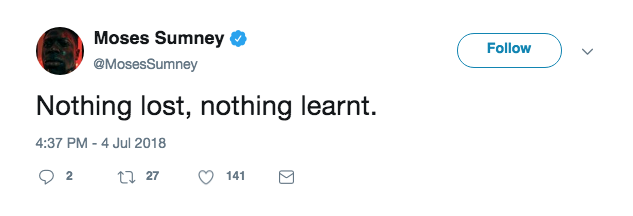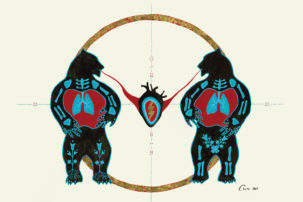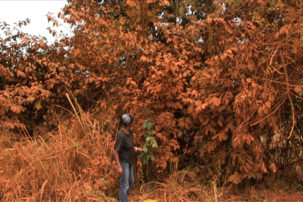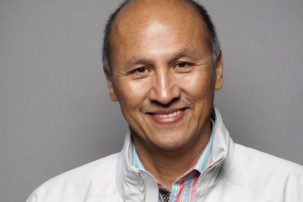When I arrived to Kapwani Kiwanga’s exhibition “Sunlight by Fireside,” I had just read the part in Maggie Nelson’s Bluets—an emo meditation on the literal, metaphorical and mood manifestations of blue—where she describes how the colour blue reprieved her from the vile orange of the restaurant where she worked. At the Musée d’art de Joliette that day, the optical case was almost the opposite: the orange cloth that Kiwanga draped across the ceiling, right over fluorescent lights, cast the room like the later stages of a sunset, offering reprieve from the sweltering heat and the glaring sun and the impenetrable late July air. A mound of dirt runs across a portion of the room’s length in proximity to a shelf with a pail and clay scoop.
The same person who recommended Maggie Nelson’s Bluets to me two weeks earlier had just texted me that they were strung out on Joni Mitchell’s Blue when I walked in on two white Québécois baby-boomer couples led by a tour guide from the same demographic. One woman used the clay cone to scoop the earth from the mound into the pail, covered it, then exited the gallery with it in tow. I approached her friend and asked her what was up. “Each country in Europe wanted a place in Africa, to take the precious things that were there,” she said. When her friend returned, she added that this mound of dirt had been extracted from the Joliette’s front lawn. “We have to—if we want to—replace it, one small piece at a time. It’s like you’re ready to give it back.”
“Even though it was never yours,” I say. “What did it feel like for you to participate in it?” I asked her.
“It’s a game—c’est comme embarquer dans l’experience.” “Play with it,” she encouraged me.
The tour guide then approached me and my friend—a writer, editor and one of my mentors, who is Palestinian—with instructions. “You take the earth and you put it outside. It’s just like the way colonialists take things and never give them back; [it’s] a way to understand that if we take something we have to return it.” She tells me the earth was sterilized, to eradicate living organisms, and outside you can see the rectangular hole in the ground that it was taken from. Joliette is on Nitaskinan territory, home to the Atikamekw First Nation, “who have been negotiating their comprehensive land claim with the governments of Quebec and Canada since 1980,” writes curator Anne-Marie St-Jean Aubre. “If the daily consequences of this reality have no direct effect on most Québécois, it certainly generates a feeling of injustice amongst Indigenous peoples, and undermines their confidence in authorities in general, and in the crown in particular.”
“Have people been participating?” my friend asked the guide.
“Yes,” she said. “Adults, not very much. But children, very much.” I asked why. “Because adults do things when they are useful. This is not useful,” she said. “But people with me have done it, because I tell them, ‘It’s funny. Try it.’”
Kiwanga studied anthropology and comparative religion, and she tends to investigate the symptoms of superstructures and their insidious apparatuses of control. Her recent immersive light environment pink-blue circulated widely via selfies taken at the Power Plant last year and the Esker Foundation this year. Rendering one half of a corridor in Baker-Miller Pink (which was tested in prison cells in the 1960s to reduce prisoner violence, to no avail) and the other in IV injection–deterrent blue light (which ultimately doesn’t deter from injection at all, but rather makes it unsafe) revealed how elements of design and architecture are employed to control marginalized bodies. “I took something that historically is quite violent and extracted it,” Kiwanga told me of that work in an interview earlier this year, “[then] put it under the microscope with this abstract gesture.”
“Sunlight by Fireside” follows suit: her deployment of the formal language of minimalism alludes to the exchange of land in global colonial processes. In Positive-Negative (morphology), her removal of earth and placing it in the gallery ought to serve as a reminder of colonial plundering when she invokes a participatory gesture that—supposedly—symbolically undoes it.
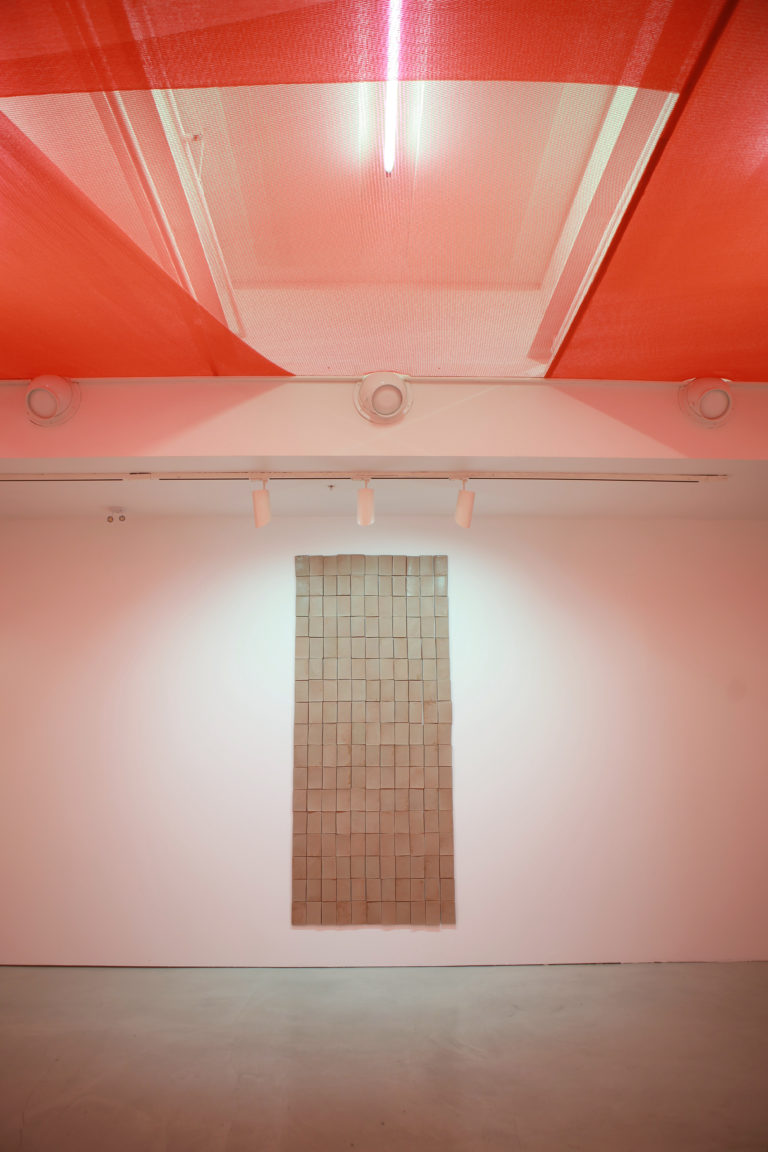 Kapwani Kiwanga, Fire & Fallow , 2018. Ceramic tiles with ash-based glaze, 10 x 15 cm each. Courtesy the artist. Photo: Ysabelle Forest.
Kapwani Kiwanga, Fire & Fallow , 2018. Ceramic tiles with ash-based glaze, 10 x 15 cm each. Courtesy the artist. Photo: Ysabelle Forest.
Fire & Fallow is another piece in which Kiwanga deploys minimalist formal language to embody decolonial politics. A grid of rectangular clay tiles—made in Joliette with clay from Grand-Métis, like the other clay components in the exhibition—compose a rectangular wall panel that carries the vestiges of another participatory gesture. At sundown seven days before the opening, Kiwanga invited participants to gather around a fire pit in front of the museum to discuss “issues of decolonization and property in relation to environmental exploitation.” All the clay components—in which, St-Jean Aubre writes, “the memory of that exchange is imbued”—were glazed with ash from the fire around which participants gathered.
St-Jean Aubre refers to these as “gestures of reparation,” and she loosely writes about how they “draw attention not only to the complex gesture of land appropriation that underlies any colonial process, whether in Australia, Algeria, India or South Africa, but to the less common gesture of returning and/or claiming what has been taken.” The work ostensibly addresses “economic issues of land ownership in relation to the extraction and exploitation of natural resources,” and it takes on “special significance,” she writes, “in light of the recent Truth and Reconciliation commission.” What gets lost in this shorthand is that the ongoing legacy of colonialism for Indigenous people and of slavery for Black people in Quebec is not abstract. All colonial histories share some common denominators, but to address them in the same breath risks erasing their specificity and their persisting pervasiveness today. Read my colleague Lindsay Nixon’s crucial piece “Born Under the Tobacco Flower and Raised Under the Lis” for their precise elucidation of all of the ways in which the white Québécois sovereignty mentality undermines Indigenous sovereignty, and perpetuates xenophobia, anti-Blackness and Islamophobia.
Outside, the tour guide and I watched as my friend dumped the earth she gathered, back from where it was taken. They will fill the hole and cover it with grass at the end of the exhibition, the tour guide told me. “But maybe it will always appear that we have done that, and Kapwani Kiwanga wants that, because it’s like the colonialists took from Africa and never gave it back, so it’s like she wants us to.” The scar on the lawn will be an enduring trace of Kiwanga’s gesture, serving as a reminder of her exhibition, and to the tour guide, as a reminder that “[…] when you take something from other people, you have to return it.”
“How do you feel?” the tour guide asked my friend. “I feel dirty,” my friend said.

